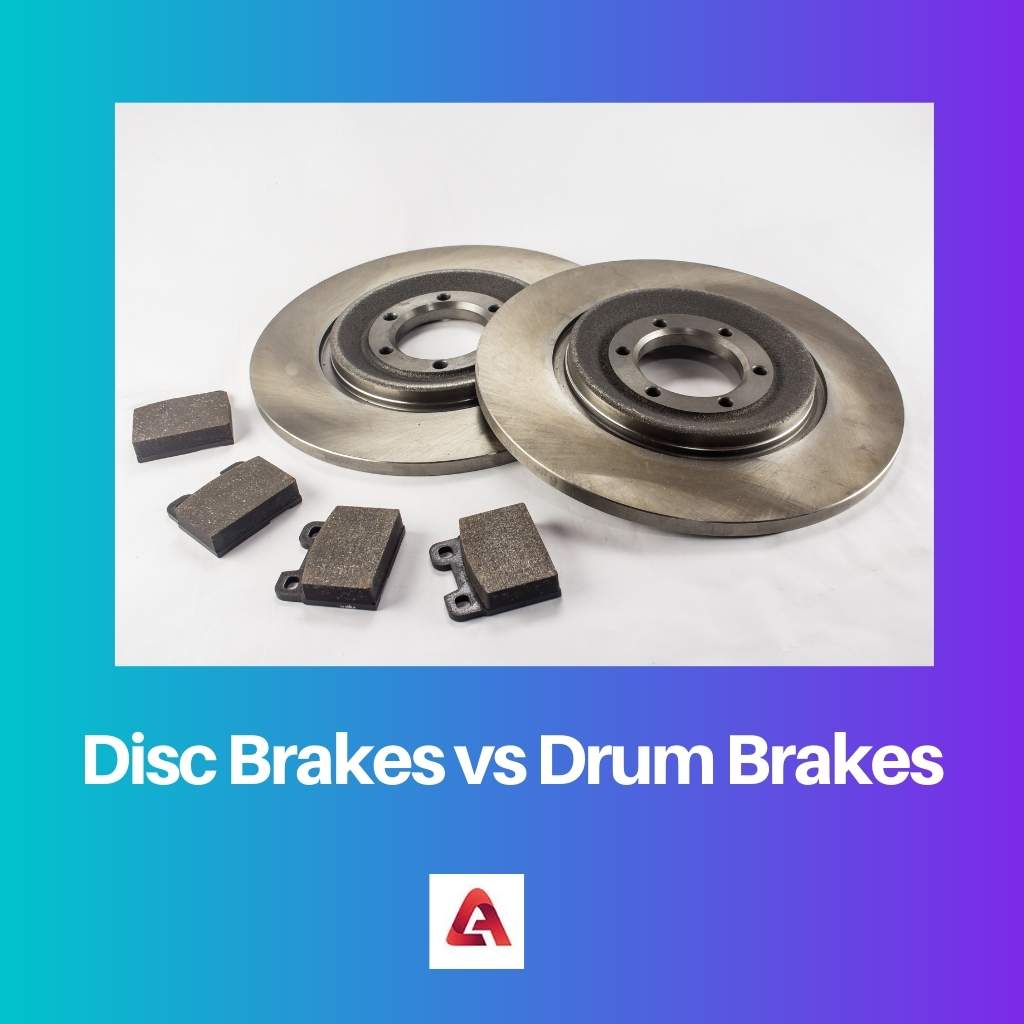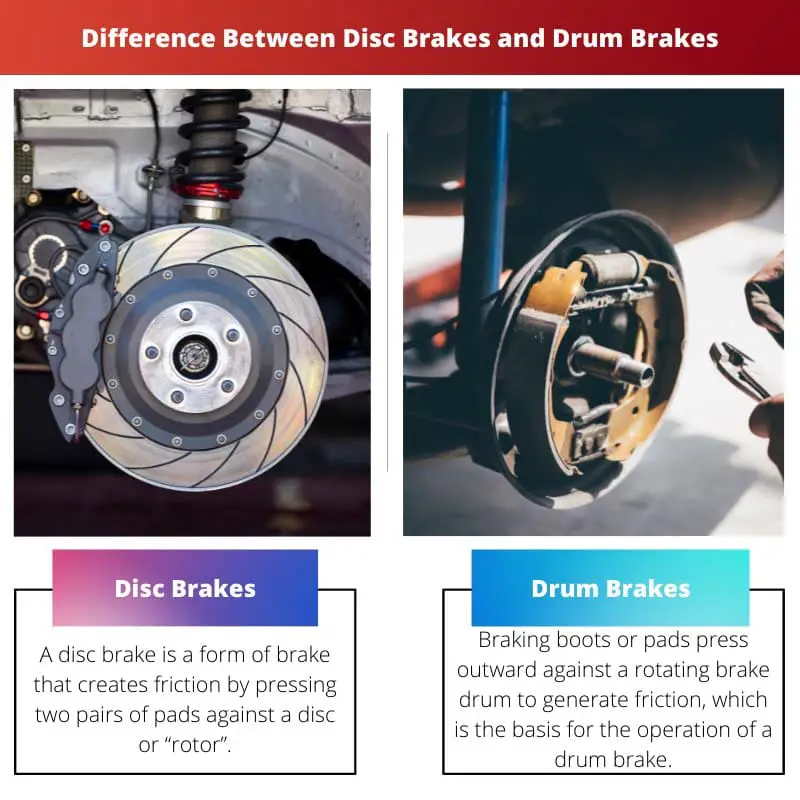Everyone enjoys the rush of acceleration and the accomplishment of new peak speeds on their motorbike or scooter.
You’ll also need braking power to go back to zero safely. Yes, the motorcycle’s brakes are more vital than the engine. That’s one thing if you don’t pay attention to your bike’s braking system.
Disc brakes and drum brakes are the two brakes that help out in the braking system slowing down your vehicle.
Key Takeaways
- Disc brakes use a rotor and caliper to slow down or stop a vehicle, while drum brakes use a drum and shoes.
- Disc brakes provide better stopping power and are more efficient at dissipating heat, while drum brakes are less expensive and easier to maintain.
- Disc brakes are commonly used on high-performance vehicles, while drum brakes are used on lower-end vehicles.
Disc Brakes vs Drum Brakes
Disc brakes are a type of brake that creates friction when pairs of pads are pressed against a rotor or disc with callipers, and this slows the rotation of the shaft to lessen its spin. Drum brakes are a type of brake that makes friction by pads or boots pushing against the revolving restraining drum outwardly.

A disc brake is a kind of brake that creates friction by pressing pairs of pads against a disc or “rotor” using callipers. This operation slows the rotation of a shaft, such as a vehicle axle, to either lessen or stop its spin.
Motion energy is transformed into waste heat that must be dissipated. Apart from these two systems, nothing else is fitted on bikes and scooters across the world.
To put it another way, a drum brake is a type of brake that relies on the friction created by a set of boots or pads pushing outward against the revolving restraining drum.
The phrase “drum brake” refers to a brake in which the shoes press on the drum’s inner surface. Clasp brakes are used when shoes push on the exterior of the drum.
Comparison Table
| Parameters of Comparison | Disc Brake | Drum Brake |
|---|---|---|
| Price | Disc brakes are more expensive than drum brakes. | A drum brake is less expensive than a disc brake. |
| Temperature | The performance is unaffected by high temperatures. Even at extreme temperatures, the brakes are effective. | The performance is decreased at hot temperatures. |
| Braking speed | It is a quick and immediate braking system. | It is a slow braking system. |
| Dispersion of heat | Heat dissipation is faster. | Heat dissipation is slower. |
| Design | The disc brake has a simple design. | The design of a drum brake is complicated. |
| Characteristics | Disc brakes have superior anti-fade properties. | Drum brakes with weak anti-fade properties. |
What is Disc Brakes?
A disc brake is a form of brake that creates friction by pressing two pairs of pads against a disc or “rotor”. This operation slows the rotation of a shaft, such as a vehicle axle, to either lessen or stop its spin.
Motion energy is transformed into waste heat that must be dissipated.
The most popular type of brake for automobiles is hydraulically operated disc brakes, although the concept of a disc brake may be applied to nearly any spinning shaft.
On both sides of the disc, the components comprise the disc, master cylinder, and calliper (which houses the cylinder and two brake pads).
A disc brake is made out of a disc-shaped metal plate and a calliper that is attached to the wheel, and the disc spins with the car’s wheel.
To put stress on the pads, the calliper is utilized. A small portion of the disc is in contact with the calliper’s friction lining. The reaming section of the disc aids in heat dissipation to the environment.
The friction liner is connected to both pads and is utilized on both sides of the disc. The calliper is connected to the non-rotating component and applies force to both pads.

What is Drum Brakes?
Braking boots or pads press outward against a rotating brake drum to generate friction, which is the basis for the operation of a drum brake.
The phrase “drum brake” refers to a brake in which the shoes press on the drum’s inner surface. Clasp brakes are used when shoes push on the exterior of the drum.
A pinch drum brake is one in which the drum is squeezed between two shoes, comparable to a standard disc brake, however, such brakes are very uncommon.
A band brake, for example, employs a flexible belt or “band” that wraps around the exterior of the drum.
In the case of a vehicle, a drum brake is a tiny drum that spins with the wheel and contains a pair of brake shoes.
When the brake paddle is pressed, the brake shoes are driven against the drum’s sidewalls, causing friction to apply brakes.
When a car is driven through water or washed, brake water collects inside the drum. The braking efficiency is harmed as a result of water accumulation.
Drum brakes are ineffective at high speeds because when the brake is applied, a larger quantity of heat is generated owing to friction, resulting in overheating.

Main Differences Between Disc Brakes and Drum Brakes
- Disc brakes are more expensive than drum brakes, whereas A drum brake is less expensive than a disc brake
- The performance of the Disc Brake is unaffected by high temperatures. Even at extreme temperatures, the brakes are effective, while the performance of the Drum Brake is decreased at hot temperatures.
- Disc brakes have a quick and immediate braking system, but Drum brakes have a slow braking system.
- In Disc brakes, heat dissipation is faster, whereas in Drum brakes, heat dissipation is slower.
- Disc brakes have superior anti-fade properties, but Drum brakes have weak anti-fade properties.
- The disc brake has a simple design, while the design of a drum brake is complicated.


The focus on the technical aspects of disc and drum brakes provides a detailed understanding for riders. It’s refreshing to see an article that delves into the mechanics of these crucial safety components.
The in-depth comparison provides riders with valuable insights into the differences between disc and drum brakes. It’s clear that braking systems are crucial for vehicle safety, and this article does a great job of explaining their operation.
This article is a great resource for riders who want to understand the intricacies of disc and drum brakes. It’s crucial to have this knowledge when it comes to the safety of motorcycle and scooter riders.
The article provides an in-depth comparison of disc and drum brakes, which makes for an informative read for motorcycle and scooter enthusiasts. It’s great to see an emphasis on the importance of braking systems for vehicle safety.
As an engineering enthusiast, the in-depth explanation of how disc and drum brakes work is fascinating. Understanding the physics behind these braking systems is crucial to appreciating their effectiveness.
The article does a great job of dissecting the differences between disc and drum brakes. It’s important to recognize that both have their own advantages and drawbacks, and riders should choose based on their specific needs.
The depth of the comparison between disc and drum brakes is impressive. This is the kind of detailed information that all riders should be aware of in order to make informed choices about their vehicle’s braking system.
This detailed analysis of disc and drum brakes is a reminder of how important it is for vehicle safety. Riders should definitely consider the information provided here before making decisions on braking systems.
The coverage of disc and drum brakes in this article is both enlightening and valuable for riders. It’s essential to understand the intricacies of these crucial components for motorcycle and scooter safety.
This piece provides a comprehensive understanding of the differences between disc and drum brakes, emphasizing the significance of braking systems for vehicle safety. Riders will undoubtedly find this information very valuable.
The comparison table effectively summarizes the key differences between disc and drum brakes, allowing riders to make informed decisions about their vehicle’s braking system.
Understanding the differences between disc and drum brakes is fundamental for riders. This article provides a comprehensive analysis that highlights the importance of braking systems for motorcycle and scooter safety.
The comparison table is very useful and clearly outlines the differences between disc and drum brakes. It’s crucial for riders to understand these differences and make informed decisions when it comes to the braking system of their vehicles.
I’m glad that the article stresses the importance of braking systems, and the advantages and disadvantages of both disc and drum brakes are presented. This will help riders make informed decisions about their vehicle’s safety.